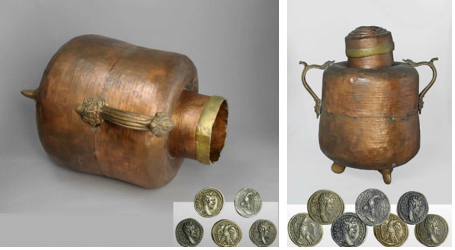A new archaeological display was launched yesterday (September 23) in the lobby of the recently renovated Bank of Israel headquarters in Jerusalem. The impressive display, which was dedicated in the presence of Bank of Israel Director General Hezi Kalo and Israel Antiquities Authority Director Yisrael Hasson, shows spectacular ancient coin hoards alongside the special containers in which they were found. Two of the three hoards were revealed to the public for the first time.
The most ancient hoard currently on display comes from archaeological excavations led by Yigael Yadin at Massada in 1963. During the excavation, this hoard drew the public's attention. It included 12 shekel and half-shekel coins minted in Jerusalem during the great rebellion against the Romans, as well as a rare coin from the first year of the rebellion. This hoard was found under the floor of the zealot leadership's main command building at the site. It was buried in a special bronze container—a medicinal cupping vessel.
The center of the display features coins from the largest hoard ever to be found in Israel, which was found in excavations at Mamshit in the Negev. This hoard contained 10,421 large silver coins, and was hidden in the early third century CE. The value of the coins in the hoard has been estimated at roughly the annual salaries of 400 Roman legionary soldiers. The large engraved copper vessel in which it was found is on display alongside a large selection of coins from the hoard.
Another special hoard, the most recent in the display, presents 47 pure gold coins that were part of a larger hoard found in Beit She'an and dated to the beginning of the Byzantine–Christian period in Israel.
Dr. Donald Tzvi Ariel, head of the Coins Division at the Israel Antiquities Authority, said, "The display of the most important ancient coin hoards discovered in the past 75 years adds a special touch to the headquarters of the Bank, which is now entrusted with the Israeli currency. The hoards take us back to human moments in history, to points in time when—in the absence of secured banks like we have today—private individuals or government clerks hid private or public capital with the aim of returning to collect it. But it seems that their luck ran out, and they were unable to come back to take it. These hoards were then discovered after hundreds or thousands of years in archaeological excavations."
In the entrance lobby of the Bank, at the center of which the hoards are on display, a comprehensive exhibit has been installed displaying the banknotes and coins of the State of Israel, alongside paintings and sculptures by Israel Prize winning artists. Works by modern Israeli artists have also been integrated throughout the Bank.
Bank of Israel Director General Hezi Kalo said, "It is very important to display assets from our culture, legacy, and artistic works at the headquarters of the central bank. These include some of the most important archaeological finds of recent years and artistic works by Israel Prize winning artists as well as by modern Israeli artists, reflecting local creativity. The ancient coins are a historical asset of the Jewish nation and the State of Israel. This Bank of Israel exhibit that both preserves them and displays them to the public emphasizes the value of identity and shows how the legacy of the nation and the State is reflected in the design of the banknotes and coins."
The artists whose works are on display in the exhibit include Menashe Kadishman, Yehiel Shemi, Yigael Tumarkin, Leah Nikel, Shai Azulai, Alon Kedem, Simon Pinto, Tal Yerushalmi, and Yair Barak.
Visits to the exhibit can be arranged through guided tours during summer and holiday vacations, and by prior arrangement with the Bank of Israel Visitors Center at 03-564-0781/2
Exhibit Curator: Ravit Dekel. Display designer: Nitzan Refaeli
Credit: Bank of Israel Spokesperson's Office
 |
Credit: Clara Amit, Israel Antiquities Authority
